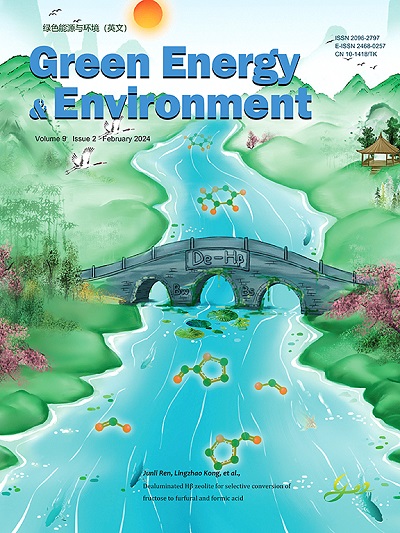Energy transfer enhanced photocatalytic hydrogen evolution in organic heterostructure nanoparticles via flash nanoprecipitation processing
IF 10.7
1区 工程技术
Q1 CHEMISTRY, PHYSICAL
引用次数: 0
Abstract
Organic nanophotocatalysts are promising candidates for solar fuels production, but they still face the challenge of unfavorable geminate recombination due to the limited exciton diffusion lengths. Here, we introduce a binary nanophotocatalyst fabricated by blending two polymers, PS-PEG5 (PS) and PBT-PEG5 (PBT), with matched absorption and emission spectra, enabling a Förster resonance energy transfer (FRET) process for enhanced photocatalysis. These heterostructure nanophotocatalysts are processed using a facile and scalable flash nanoprecipitation (FNP) technique with precious kinetic control over binary nanoparticle formation. The resulting nanoparticles exhibits an exceptional photocatalytic hydrogen evolution rate up to 65 mmol g h, 2.5 times higher than that single component nanoparticle. Characterizations through fluorescence spectra and transient absorption spectra confirm the hetero-energy transfer within the binary nanoparticles, which prolongs the excited-state lifetime and extends the namely “effective exciton diffusion length”. Our finding opens new avenues for designing efficient organic photocatalysts by improving exciton migration.

通过闪速纳米沉淀处理增强有机异质结构纳米粒子的能量转移光催化氢进化能力
有机纳米光催化剂是太阳能燃料生产的理想候选材料,但由于激子扩散长度有限,它们仍然面临着不利的宝石化重组挑战。在这里,我们介绍了一种二元纳米光催化剂,它是由两种聚合物(PS-PEG5(PS)和 PBT-PEG5(PBT))混合制成的,这两种聚合物的吸收光谱和发射光谱相匹配,从而实现了弗斯特共振能量转移(FRET)过程,增强了光催化功能。这些异质结构纳米光催化剂是利用一种简便、可扩展的闪速纳米沉淀(FNP)技术加工而成的,对二元纳米粒子的形成具有珍贵的动力学控制。所得到的纳米粒子具有优异的光催化氢进化率,高达 65 mmol g h,是单组分纳米粒子的 2.5 倍。通过荧光光谱和瞬态吸收光谱进行的表征证实了二元纳米粒子内部的异能传递,这延长了激发态的寿命,并延长了 "有效激子扩散长度"。我们的发现为通过改善激子迁移设计高效有机光催化剂开辟了新途径。
本文章由计算机程序翻译,如有差异,请以英文原文为准。
求助全文
约1分钟内获得全文
求助全文
来源期刊

Green Energy & Environment
Energy-Renewable Energy, Sustainability and the Environment
CiteScore
16.80
自引率
3.80%
发文量
332
审稿时长
12 days
期刊介绍:
Green Energy & Environment (GEE) is an internationally recognized journal that undergoes a rigorous peer-review process. It focuses on interdisciplinary research related to green energy and the environment, covering a wide range of topics including biofuel and bioenergy, energy storage and networks, catalysis for sustainable processes, and materials for energy and the environment. GEE has a broad scope and encourages the submission of original and innovative research in both fundamental and engineering fields. Additionally, GEE serves as a platform for discussions, summaries, reviews, and previews of the impact of green energy on the eco-environment.
 求助内容:
求助内容: 应助结果提醒方式:
应助结果提醒方式:


